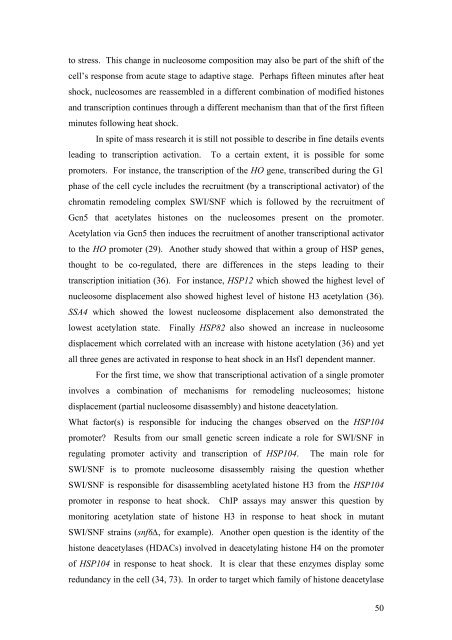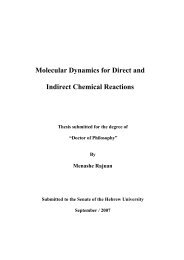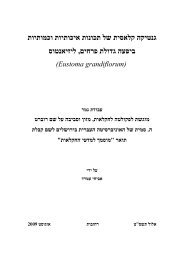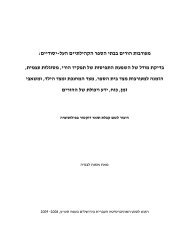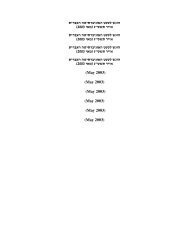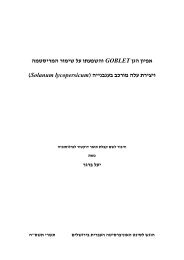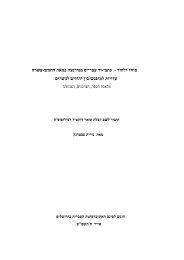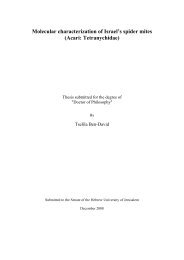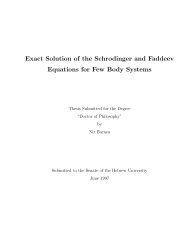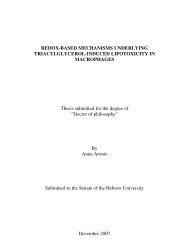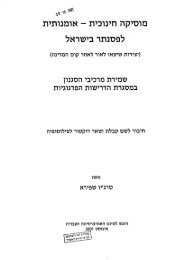Revealing the Mechanism of HSP104 Transcription Initiation in the ...
Revealing the Mechanism of HSP104 Transcription Initiation in the ...
Revealing the Mechanism of HSP104 Transcription Initiation in the ...
Create successful ePaper yourself
Turn your PDF publications into a flip-book with our unique Google optimized e-Paper software.
to stress. This change <strong>in</strong> nucleosome composition may also be part <strong>of</strong> <strong>the</strong> shift <strong>of</strong> <strong>the</strong><br />
cell’s response from acute stage to adaptive stage. Perhaps fifteen m<strong>in</strong>utes after heat<br />
shock, nucleosomes are reassembled <strong>in</strong> a different comb<strong>in</strong>ation <strong>of</strong> modified histones<br />
and transcription cont<strong>in</strong>ues through a different mechanism than that <strong>of</strong> <strong>the</strong> first fifteen<br />
m<strong>in</strong>utes follow<strong>in</strong>g heat shock.<br />
In spite <strong>of</strong> mass research it is still not possible to describe <strong>in</strong> f<strong>in</strong>e details events<br />
lead<strong>in</strong>g to transcription activation. To a certa<strong>in</strong> extent, it is possible for some<br />
promoters. For <strong>in</strong>stance, <strong>the</strong> transcription <strong>of</strong> <strong>the</strong> HO gene, transcribed dur<strong>in</strong>g <strong>the</strong> G1<br />
phase <strong>of</strong> <strong>the</strong> cell cycle <strong>in</strong>cludes <strong>the</strong> recruitment (by a transcriptional activator) <strong>of</strong> <strong>the</strong><br />
chromat<strong>in</strong> remodel<strong>in</strong>g complex SWI/SNF which is followed by <strong>the</strong> recruitment <strong>of</strong><br />
Gcn5 that acetylates histones on <strong>the</strong> nucleosomes present on <strong>the</strong> promoter.<br />
Acetylation via Gcn5 <strong>the</strong>n <strong>in</strong>duces <strong>the</strong> recruitment <strong>of</strong> ano<strong>the</strong>r transcriptional activator<br />
to <strong>the</strong> HO promoter (29). Ano<strong>the</strong>r study showed that with<strong>in</strong> a group <strong>of</strong> HSP genes,<br />
thought to be co-regulated, <strong>the</strong>re are differences <strong>in</strong> <strong>the</strong> steps lead<strong>in</strong>g to <strong>the</strong>ir<br />
transcription <strong>in</strong>itiation (36). For <strong>in</strong>stance, HSP12 which showed <strong>the</strong> highest level <strong>of</strong><br />
nucleosome displacement also showed highest level <strong>of</strong> histone H3 acetylation (36).<br />
SSA4 which showed <strong>the</strong> lowest nucleosome displacement also demonstrated <strong>the</strong><br />
lowest acetylation state. F<strong>in</strong>ally HSP82 also showed an <strong>in</strong>crease <strong>in</strong> nucleosome<br />
displacement which correlated with an <strong>in</strong>crease with histone acetylation (36) and yet<br />
all three genes are activated <strong>in</strong> response to heat shock <strong>in</strong> an Hsf1 dependent manner.<br />
For <strong>the</strong> first time, we show that transcriptional activation <strong>of</strong> a s<strong>in</strong>gle promoter<br />
<strong>in</strong>volves a comb<strong>in</strong>ation <strong>of</strong> mechanisms for remodel<strong>in</strong>g nucleosomes; histone<br />
displacement (partial nucleosome disassembly) and histone deacetylation.<br />
What factor(s) is responsible for <strong>in</strong>duc<strong>in</strong>g <strong>the</strong> changes observed on <strong>the</strong> <strong>HSP104</strong><br />
promoter? Results from our small genetic screen <strong>in</strong>dicate a role for SWI/SNF <strong>in</strong><br />
regulat<strong>in</strong>g promoter activity and transcription <strong>of</strong> <strong>HSP104</strong>. The ma<strong>in</strong> role for<br />
SWI/SNF is to promote nucleosome disassembly rais<strong>in</strong>g <strong>the</strong> question whe<strong>the</strong>r<br />
SWI/SNF is responsible for disassembl<strong>in</strong>g acetylated histone H3 from <strong>the</strong> <strong>HSP104</strong><br />
promoter <strong>in</strong> response to heat shock. ChIP assays may answer this question by<br />
monitor<strong>in</strong>g acetylation state <strong>of</strong> histone H3 <strong>in</strong> response to heat shock <strong>in</strong> mutant<br />
SWI/SNF stra<strong>in</strong>s (snf6∆, for example). Ano<strong>the</strong>r open question is <strong>the</strong> identity <strong>of</strong> <strong>the</strong><br />
histone deacetylases (HDACs) <strong>in</strong>volved <strong>in</strong> deacetylat<strong>in</strong>g histone H4 on <strong>the</strong> promoter<br />
<strong>of</strong> <strong>HSP104</strong> <strong>in</strong> response to heat shock. It is clear that <strong>the</strong>se enzymes display some<br />
redundancy <strong>in</strong> <strong>the</strong> cell (34, 73). In order to target which family <strong>of</strong> histone deacetylase<br />
50


